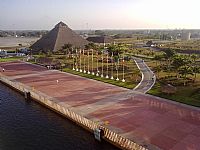Posted on Wednesday, January 5, 2011 by
Randy tagged as
regent voyager Puerto Chiapas, Mexico |
After a day at sea, we've arrived in Puerto Chiapas, Mexico. This southernmost cruise port in Mexico is just a few miles from the Guatemala border.
Before meeting for our 8:30am shore excursion we try out La Veranda, the buffet dining venue aboard the Voyager. In typical cruise ship layout, this buffet is on the top and rear of the ship utilizing a fantail outdoor area for al-fresco dining. We find the selections of fruit and pastries to be fairly extensive, however the selection of potatoes, breakfast meats and eggs seems very limited. The only egg selection appears to be at the omelet station which introduces a higher than average demand, and therefore delay, with the omelet chefs.
Our meeting spot for the shore excursion is in the Constellation Theatre, the main theatre onboard. After a quick check-in procedure, our reservation ticket is exchanged for a bus token. When released, our group meets the tour leader on the pier and are escorted to a new, top of the line motor coach. During our approximately 40 minute drive to our first stop, our guide introduces us to various sites along the route. We're bound for Mi Pueblito, a small village known for its central plaza and nearby church that is recognized as the oldest in the Mexican Republic. After arriving, we're seated in a small central plaza theatre area for a musical and dancing performance.
The main interest of this excursion is related to chocolate making. This region of Central America produce much of the world's chocolate. The demonstration of how the ancient Mayan made chocolate is quite interesting. A women in native dress shows us how the coco beans are extracted from the raw fruit (even letting us taste the raw bean). She tells us how the women of the villages would dry and then roast the chocolate followed by what must have been muscle aching work over stones that crushed and ground the remaining center of the bean. We were treated to tastes of this raw chocolate paste, both in its natural state (very bitter) and with the typical Mexican cinnamon added. While much of the raw coco production is still done in this region, the coco bean is only taken through the drying stage before export to chocolate giants in the US and Europe. Nestle, Cadbury and others prefer to finalize the production by controlled roasting and grinding in their own facilities.
After a quick visit to the historic church, we again board the coach headed to Izapa, an extensive complex of pre-Columbian ruins dating back to 1500BC. These ruins have been partially reconstructed, however are not nearly as impressive as those along the east coast of Mexico. We spend about 40 minutes at Izapa, and then reboard the coach back to the pier.
This afternoon is spent doing some work and mostly relaxing onboard. We join many of the other guests on high decks for our departure. The small bay and beaches around Puerto Chiapas light up with the golden glow of sunset as we sail back out into the Pacific toward our next stop in Huatulco, Mexico.



